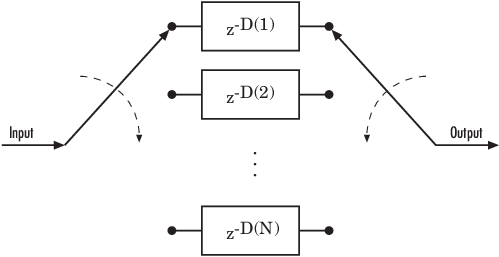convdeintrlv
Restore ordering of symbols using shift registers
Syntax
deintrlved = convdeintrlv(data,nrows,slope)
[deintrlved,state] = convdeintrlv(data,nrows,slope)
[deintrlved,state] = convdeintrlv(data,nrows,slope,init_state)
Description
deintrlved = convdeintrlv(data,nrows,slope) restores
the ordering of elements in data by using a set of
nrows internal shift registers. slope is the
register length step. For information about delays, see Delays of Convolutional Interleaving and Deinterleaving.
[deintrlved,state] = convdeintrlv(data,nrows,slope) returns
a structure that holds the final state of the shift registers. state.value stores
any unshifted symbols. state.index is the index
of the next register to be shifted.
[deintrlved,state] = convdeintrlv(data,nrows,slope,init_state) initializes
the shift registers with the symbols contained in init_state.value and
directs the first input symbol to the shift register referenced by init_state.index.
The structure init_state is typically the state output
from a previous call to this same function, and is unrelated to the
corresponding interleaver.
Using an Interleaver-Deinterleaver Pair
To use this function as an inverse of the convintrlv function, use the same
nrows and slope inputs in both functions.
In that case, the two functions are inverses in the sense that applying
convintrlv followed by convdeintrlv
leaves data unchanged, after you take their combined delay of
nrows*(nrows-1)*slope into account. For information about
delays, see Delays of Convolutional Interleaving and Deinterleaving.
Examples
The example in Effect of Delays on Recovery of Convolutionally Interleaved Data Using MATLAB uses convdeintrlv and
illustrates how you can handle the delay of the interleaver/deinterleaver
pair when recovering data.
The example on the reference page for muxdeintrlv illustrates
how to use the state output and init_state input
with that function; the process is analogous for this function.
More About
References
[1] Heegard, Chris and Stephen B. Wicker. Turbo Coding. Boston: Kluwer Academic Publishers, 1999.
Version History
Introduced before R2006a

